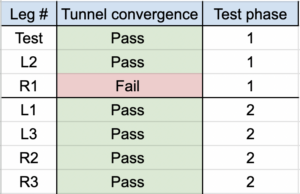Functional requirements tested:
Functional requirements were taken from the original list created at the start of the design process. Since then the team has narrowed down on the functional requirements that are feasible to test with mirage:
- Must avoid tunnel convergence
- The main purpose of our device is to reduce the likelihood of tunnel conflict. Testing the tunnel convergence was done by placing a pencil into the ALCR tunnel and drilling the ALLR hole. After drilling was complete, the pencil was removed from the knee and examined. If there were any nicks on the pencil, then the device did not prevent tunnel convergence. If there were not any nicks on the pencil, tunnel convergence did not occur.
- Guide should operate using the minimum required number of portals
- Minimum number of portals was considered, but since the ALLR guide will reuse portals from the ALLR graft harvest and ACLR guide, a portal test was not necessary.
- Proper drilling Location
- The desired drilling location was distal and posterior to the ACLR tunnel. Drilling location was confirmed by examining where the hole was created in reference to the previously drilled ACLR tunnel.
- Proper drilling angle
- The desired drilling angle was anterior and proximal. After drilling and removing the pencil, it was easy to see if the desired angle location had been achieved.
All other functional requirements such as stiffness, biocompatibility, sanitization ability, and ergonomics were to be evaluated based on material properties and not tested directly. Since mirage is not created as a final prototype created with the ideal materials and is made up of mostly PLA, material requirements were not taken into account at this stage.
Testing Procedure:
Testing was completed in two main phases as we learned and made changes to the prototype
Phase one:
Originally the functional requirements to be tested included adjustability. To complete this, paper mache covered the bones to simulate varying knee sizes for a patient. Upon testing, three main problems emerged:
- Paper mache caused the ALLR drill to slip off the bone
- The T tube that the ALLR drill entered through had too short of an arm and did not allow for the tunnel to be placed in the correct location
- Too many degrees of freedom made handling the device difficult and unreliable
From these complications, design of the prototype and testing protocol changes were made.
Phase two:
To start phase two, the team addressed the problems identified. Paper mache was removed from the bones and adjustability was no longer evaluated. The T tube arm was extended to allow for a better drilling location. Additionally, all degrees of freedom were locked and kept constant for each testing trial. These changes allowed for a successful prototype test.
Data was not analytically analyzed. Our results gave us specific conclusions about the next steps of our design.
Key results from Mirage testing phase two show that the prototype is capable of avoiding tunnel conflict. Difficulties with Mirage emerged which include needing to curve the T tube arm to allow for a better entry angle for the ALLR tunnel. The T tube should also include a longer tube to restrict movement of the drill. Finally we learned that it is important to have all parts of Mirage machined out of aluminum due to the play in PLA. This play resulted in unwanted degrees of freedom.

For more information on testing please see the testing protocol